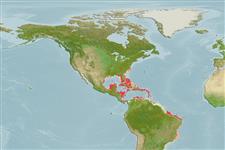Environment: milieu / climate zone / depth range / distribution range
Écologie
marin; saumâtre récifal. Subtropical
Western Atlantic: Bermuda, Florida Keys (USA), and Bahamas to northern South America. Scarce in western Gulf of Mexico (Ref. 26938).
Taille / Poids / Âge
Maturity: Lm ? range ? - ? cm
Max length : 15.0 cm TL mâle / non sexé; (Ref. 7251); 50.0 cm TL (female)
A very, slender, elongate, cylindrical eel with a projecting lower jaw. Lateral line complete ending at base of tail. (Ref. 26938).
Young and females burrow in sandy tide pools and reef tracts. Males inhabit deeper water, possibly pelagic. Adults emerge at night and sometimes come to lights at the surface (Ref. 26938). Feed on burrowing invertebrates that live in the sand (Ref. 26938).
Life cycle and mating behavior
Maturities | Reproduction | Spawnings | Egg(s) | Fecundities | Larves
Robins, C.R. and G.C. Ray, 1986. A field guide to Atlantic coast fishes of North America. Houghton Mifflin Company, Boston, U.S.A. 354 p. (Ref. 7251)
Statut dans la liste rouge de l'IUCN (Ref. 130435)
Menace pour l'homme
Harmless
Utilisations par l'homme
Outils
Articles particuliers
Télécharger en XML
Sources Internet
Estimates based on models
Preferred temperature (Ref.
123201): 23.8 - 28.2, mean 27.3 °C (based on 786 cells).
Phylogenetic diversity index (Ref.
82804): PD
50 = 0.5003 [Uniqueness, from 0.5 = low to 2.0 = high].
Bayesian length-weight: a=0.00102 (0.00046 - 0.00225), b=3.06 (2.88 - 3.24), in cm total length, based on all LWR estimates for this body shape (Ref.
93245).
Niveau trophique (Ref.
69278): 3.5 ±0.37 se; based on food items.
Fishing Vulnerability (Ref.
59153): Moderate vulnerability (40 of 100).
Nutrients (Ref.
124155): Calcium = 50 [20, 135] mg/100g; Iron = 0.584 [0.290, 1.102] mg/100g; Protein = 19.1 [16.8, 21.6] %; Omega3 = 0.203 [0.081, 0.560] g/100g; Selenium = 10.4 [4.1, 25.2] μg/100g; VitaminA = 114 [26, 489] μg/100g; Zinc = 1.4 [0.8, 2.2] mg/100g (wet weight);
